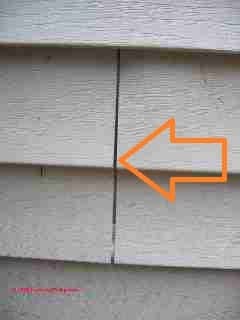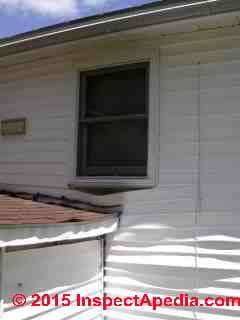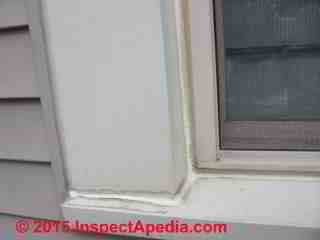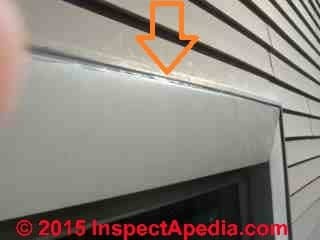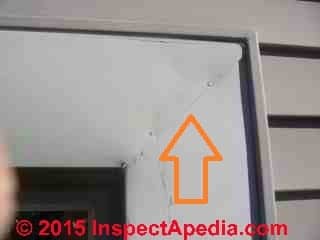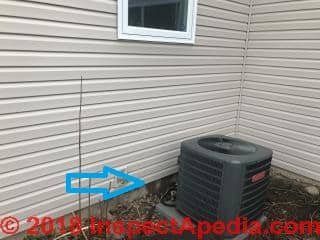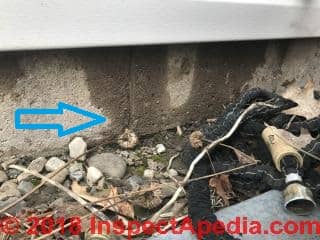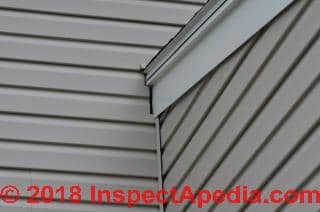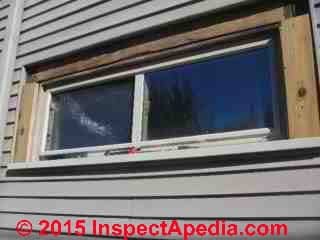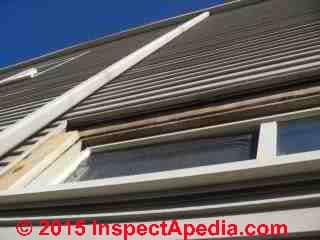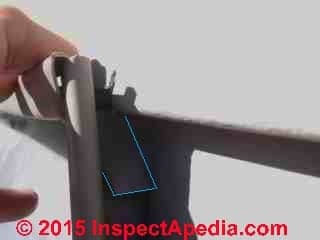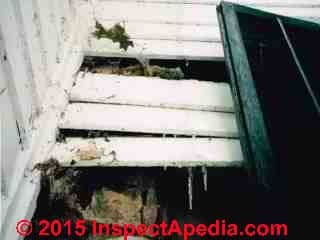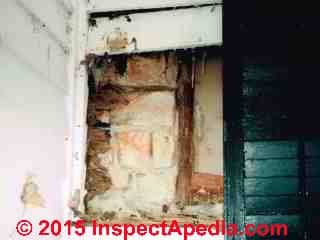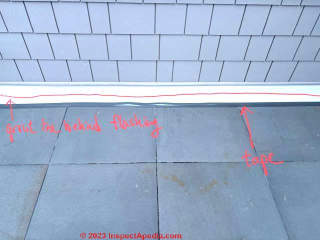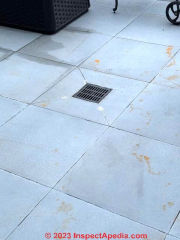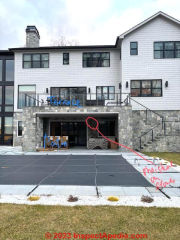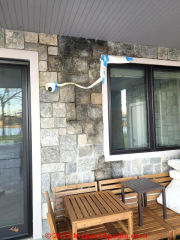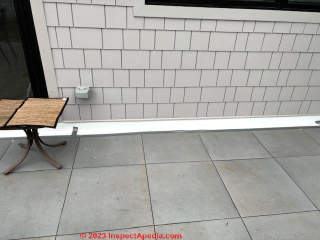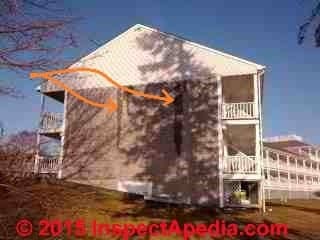 Siding Leak Troubleshooting
Siding Leak Troubleshooting
Diagnose, repair or prevent leaky siding
- POST a QUESTION or COMMENT about leaks in building walls or siding
Siding leak diagnosis and repair:
Siding isn't waterproof; but how do we find the source of leaks in aluminum siding, vinyl siding or other building siding systems? How can we prevent or repair leaky building siding?
This article describes the causes of all types of leaks in building siding and wall coverings. Using detailed examples and photos of leaky building siding, siding stains, ice, or other leak clues for vinyl siding we illustrate the installation mistakes or subsequent siding damage that can cause troublesome, even dangerous leaks into a building wall or wall structure.
The article includes a catalog of all sorts of causes of leaks into building walls and provides links to in-depth diagnostic and repair articles for each of them. Our page top photo shows water leaking out of gable end siding on a condominium complex in Maine.
InspectAPedia tolerates no conflicts of interest. We have no relationship with advertisers, products, or services discussed at this website.
- Daniel Friedman, Publisher/Editor/Author - See WHO ARE WE?
Leaky Vinyl or Aluminum Siding: cause, effects, cure
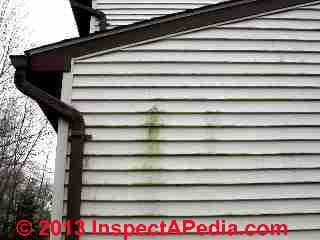 Is Vinyl Siding Waterproof?
Is Vinyl Siding Waterproof?
No. While the actual face of vinyl siding is waterproof, a vinyl sided building wall is by no means waterproof.
[Click to enlarge any image]
Watch out: vinyl siding used on building exteriors is not nor is it meant to be a waterproof barrier.
Openings at the lap joints of vinyl siding sections as well as drain openings provided along the bottom edge of most vinyl siding products let the wall system breathe and allow wind-blown rain that may enter the siding to drain out of it as well.
But if house wrap and door and window flashing were not properly installed this same water that penetrates the siding can actually enter the building wall structure. Such leaks invite insect damage, rot, and mold contamination that can be quite costly.
In our photo at above left it looks as if there is a problem with moisture behind the siding, leaking out at two of the siding panel bottom edge vents, long enough to invite a pair of algae colonies on the wall.
We suspect that that top J-channel trip at the gable end protrudes past the gable board and is not sealed.
Leaks into Siding at Gaps or Damage Points
Most of the vinyl siding problems we see appear to be due to poor installation details, though on occasion we see cracks and breaks that may be blamed on older, more brittle vinyl products. Installation gaps in siding of any type, if not back-flashed, invite leaks into the wall (above left).
Structural movement or damage, shown in a more extreme case at above right, can also allow significant leaks into the building. The horrible looking siding with a gaping siding-mouth below the window is discussed
at VINYL SIDING BUCKLED WARPED
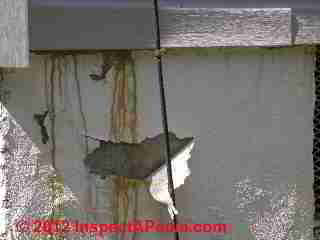 Wind-blown rain entering behind any building siding material can become a water problem.
Wind-blown rain entering behind any building siding material can become a water problem.
In this article series be sure to
review J-CHANNEL MISTAKES in Vinyl Siding Cause Costly Building Damage
as this is one of the most common causes of leaks around windows and doors of vinyl-sided buildings.
Our photo of leak stains on a foundation wall below vinyl siding (at left) suggests that either we had wind-blown rain or other exterior leaks into the building wall or there was an in-building leak or flood such as from a burst pipe.
Water passing over wood and other building materials but behind the vinyl siding can easily pick up pigments that stain the foundation wall outside.
If the builder failed to install a weather barrier, this sort of staining is more likely.
Tracking Down the Leaks in a Vinyl-Sided Building
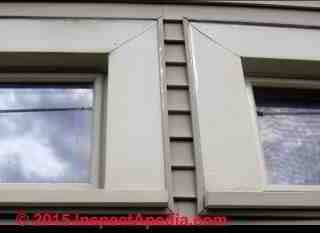 Reader Question: buckling aluminum-wrapped window frames, damaged windows, siding leaks. The Siding Rep won't agree that there is a problem
Reader Question: buckling aluminum-wrapped window frames, damaged windows, siding leaks. The Siding Rep won't agree that there is a problem
To the Editor:
I recently wrote in that there is a problem with water/moisture getting into my exterior wall cavities. The top of one rectangular window frame had buckled outward causing the aluminum window wrap to ripple and come apart at the caulked areas.
This is when I first noticed there was a problem. The rectangular window photo shows the buckled window frame top with the now replaced aluminum wrap, bent over nail included.
The building has vinyl siding installed over existing wood lap siding.
A J-channel was wrapped around all the doors and windows to receive the siding.
A workman came out and applied a sloppy bead of clear silicone where the J-channel meets the window frames including the top of the frames.
The company's rep. stated that the American Siding Institute had changed the installation method and that this was now being recommended.
I could find no reference to his claim on the Am. Siding Institute's website. I also looked at several other siding jobs in the area and none had caulk between the J-channel and window frames.
The worker also removed the old caulk from the window wrap, gouging it so you see the silver aluminum and re caulked it. It's the worst caulk job/workmanship I believe is possible.
The rep. won't acknowledge that there is any problem and is very elusive. He even suggested it was because of something I had done. And that I should be careful because he had recorded my conversations with him.
There's more but I won't bore you with further details. I have maintained my cool and friendliness throughout it all but am rather upset to put it mildly. - K.G. 1 Feb 2015
Reply: be polite, find the leaks
Troubling case report and revealing too.
If you were being polite and civil and an onsite company rep felt he had to record his conversation with you one might infer that the company or the rep have experiences with their product and field service that lead them to expect trouble.
It may help to keep in mind that for many building supplies you are not the manufacturer's client. The builder is their client.
The addition of caulk along the vertical abutment of window trim and J-channel as well as across the window top (your photo at above left) is not unusual but isn't usually required and if flashing errors were made it won't stop leaks; one wonders if the top J-channel runs were cut short and not bent over the outside of the vertical J-channels.
The open aluminum trim miter cut (your photo at above right) might be a leak into the window structure as well unless the vertical or right-hand trim was properly extended under the window top trim and sealed properly during construction. The joint looks open.
 The claim by your contractor that caulking is now recommended for vinyl siding J-channel installations is a bit confounded (sounds like arm-waving to me) and is not supported by expert documentation and standards as I include below.
The claim by your contractor that caulking is now recommended for vinyl siding J-channel installations is a bit confounded (sounds like arm-waving to me) and is not supported by expert documentation and standards as I include below.
Proper as well as improper J-channel installation details are described
at VINYL SIDING J-CHANNEL MISTAKES in Vinyl Siding Cause Costly Building Damage.
At left we illustrate extreme leaks into vinyl siding on a New York home at which the siding installer had omitted building flashing. In driving rain so much water ran into the siding (and into the building walls) that it was literally pouring out of the siding bottom (blue arrow).
The Vinyl Siding Institute (cited below) provides a vinyl siding installation manual that provides some guidelines.
There the instructions recommend applying a bead of sealant to the nailing flange of window sills to cover nails and nail slots when flashing previously-installed nail-fin windows.
This case does not apply and cannot pertain to the application of vinyl siding atop existing building siding such as on your home.
Question: leaks into a siding gap my contractor left in this vinyl siding installation job
I’m hoping you may be able to provide me advice, though I realize your ability may be limited based on the photos and information I will provide.
I purchased my home in NY and closed on 3/30/17. The house had been remodeled by a contractor in 2016 including new windows, new siding, new roof, & new gutters.
Recently I noticed a spot on the exterior foundation wall under the kitchen window that is wet when the surrounding wall is not (when it rains). It will also be wet after for some time, while the surrounding wall will not. The window does not have a jchannel installed because, I’m told, it has one built in.
This is the side of the house that receives driving rain when it rains.
Should this have a jchannel installed? And could this be the reason for the water on the foundation wall? (Photos 1 & 2 above)
On this same side of the house, where there was an addition added years ago, there is about a 2” gap in the siding where it meets the trim where the addition roof meets the house. There appears to be no flashing here, or house wrap.
(Photo 3 is the full corner and photo 4 is an enhanced closeup allowing you to see the wood wall underneath)
This should be properly flashed, am I right? Additionally, since I do not see any house wrap here - I’m concerned. I know there is what appears to be foil backed 1/2 inch styrofoam under the siding at the bottom portion of the house,
however I also know that an entire wall of my garage has none of this foam, nor does it have any house wrap under the siding - it’s just the wood under the vinyl. Shouldn’t there be house wrap around the entire structure since it was just sided in 2016?
Do I need to pay to have the house resided?
I had an inspection and none of this was noticed during the inspection.
I appreciate any advice you can provide. - Anonymous by private email 2018/05/05
Reply: evaluate vinyl siding leaks and installation details to decide what steps are needed
Indeed you did a nice job of finding what could be the principal leak point sending water behind your siding - we don't want water to run off of the lower roof and into an area behind the siding where it might enter walls and lead to a mold, insect, or rot problem.
Your photos of the siding gap show bare plywood, suggesting that there was also no housewrap.
So there may be multiple siding-leak-related problems here:
- Runoff from lower roof runs off the roof side
rather than down the roof - Water enters an open gap
in siding that should have been sealed and flashed - Housewrap may be incomplete or omitted -
see HOUSEWRAP AIR & VAPOR BARRIERS - If water is entering building walls
insulation may have been wet and need to be removed and replaced. - Watch out: A careful inspection of all of the building siding, particularly details around penetrations such as for windows, doors, light fixtures, would be in order.
Otherwise you may fix the one problem you saw but later you may be sorry you didn't find and fix its sisters.
I don't yet assume that it would be appropriate nor cost-justified to have the home re-sided, but we certainly need additional onsite inspection.
An astute onsite inspector armed with moisture meter and perhaps a willingness to cut a test opening at the most-suspect points of drywall inside - maybe behind floor trim - ought to help sort this out.
Let us know what you're told and we may be able to offer follow-up suggestions or questions to ask.
Also see the detailed flashing and housewrap suggestions in these three articles:
Proper Flashing & Sealing Around Windows & Doors
Here is how your windows (and doors) should have been prepared, excerpting from the Vinyl Siding Institute's Installation Manual for Vinyl Siding:
Flashing Previously Installed Window with Exterior Casing (Brick Mold) If a window with exterior casing (e.g., brick mold) has been previously installed without flashing, the following instructions should be followed:
- Ensure that exterior casing is sealed to the exterior sheathing or water-resistive barrier with a good quality sealant.
- Cover the exterior casing with aluminum or vinyl trim
sheet.
This can be accomplished by using a portable field brake and bending instructions from the brake manufacturer.
The trim sheet should be installed in weatherboard fashion. The bottom piece should be installed first, and each piece should overlap the piece below wherever they join. - Install rigid head flashing (i.e., drip cap) on top of the
top piece of exterior casing, covering trim sheet installed
in the previous step.
The ends of the rigid head flashing must extend to the outer edges of the exposed legs of the side J-channels.
Cut a notch on the ends of the rigid head flashing and bend them down over the sides of the exterior casing. The rigid head flashing must be sealed to the exterior sheathing and to the top of the exterior casing (Fig. 34). - Vinyl Siding Institute, cited below.
Also see PEEL & STICK FLASHING MEMBRANES
That VSI standard does not explicitly address the situation of adding layers of siding that require building out the window trim, but the principles are basically the same: you need to flash and seal the window before installing the siding and J-channel.
I'd want to get a clear idea of where the problems lie and to document them with care before trying further repairs.
- Was the trim built-out when the added siding was installed? If so how and was that part of the leak trouble?
- What caused buckling windows? Water and freezing? or water and swelling materials?
- Where exactly are the leaks? To find this answer it may be necessary to remove some of the vinyl siding and inspect what's behind it; even if housewrap was installed, if it was not installed properly, say lapped backwards or torn or incomplete, that could be part of the trouble.
Reader follow-up: plans to remove siding to find the leaks
I had an old school established roofing/siding company owner look at it yesterday and he is going to take off the siding around the buckling window to determine the problem which he says is water infiltration.
Also says not only is the caulk job poor but the caulk used is not the right type.
All 21 window's aluminum wrap is badly scratched where the worker tried to remove the old caulk. Where he couldn't remove it he simply caulked over the old.
All windows will have to be rewrapped, etc.. What was a $200 job is now going to be between $1750 - 2500.
The owner of the company who did the work said through his salesman yesterday that he believes any damage to the aluminum wrap was preexisting. He refuses to come out to look at it. I feel as if I'm dealing with sociopaths and my best shot is going to be small claims court.
Reply: take photos
Be sure to take plenty of clear photos of the siding as is now, during removal, and after removal; I'm particularly interested in water tracks and marks, missing flashing, improperly-installed housewrap, and in the end-cuts of the J-channel over windows. Send me what you can and I can comment further. All of that data may even be useful to you
Use this VINYL SIDING HOOK to Remove and Reinstall Vinyl Siding without ruining it.
Reader Follow-up:
Yes, the exploratory work begins tomorrow. I'll keep you in the loop.
Here are the photo's of the window being disassembled after the installer repaired it.
The installer tried to unsuccessfully bend the top casing board back with screws and then poorly installed a new piece of aluminum wrap.
He then silicone caulked all 21 windows where his J-channel meets the window casing effectively forcing any water/moisture into the wall cavity.
What I discovered is disturbing. The photos speak for themselves. I can literally reach into the wall cavity above this window and pull out the insulation. There is nothing to keep the water/moisture from entering the wall. - K. 9 Feb 2015
Reply:
OK but I still can't see what I want;
Look at the J-channel over the top of the window.
Look at the end of that J-channel section and see how it was cut.
It should be cut so that the bottom or "flat" portion of the J-channel is left long and then bent down over the outside of the vertical J-channel that runs along side of the window.
If the J-channel top piece was simply cut off straight or say on a 45 degree angle to miter the corner (which is what I suspect) then water running out of the horizontal J-channel ends can leak down the inside of all of the top and side and bottom J-channel segments and enter the wall.
If that is what was going on, adding caulk where it was added won't help a bit.
Reader Follow-up: Vinyl Siding J-Channel Installation Details
Here are some photos where the window top J-channel intersects with the window side J-channel. I also looked at several other windows and all had a tab off the top J-channel turned down into the side J-channel.
Reply:
It looks as if that detail was correct, except possibly for a subtle leak opening if the tab was cut on an angle so that there is an opening on the horizontal surface at the end of the J-channel that lets water not run down the tab and onto the outside of the vertical J-channel and at its end out onto the siding exposed front. (That's the intended path).
On enlarging one of your photos I observed the leak points in the aluminum-wrapped window trim shown in the photo just below
. It seems likely that water would enter behind the aluminum wrapping on these sills and depending on how the aluminum was bent behind the window sill's J-channel or behind the vinyl siding below it could certainly direct water into the building walls.
More water might pass into these gaps than one would imagine, as blown rain running down the window face will flow onto the sill and a bit of it across the sill ends and right into those two gaps.
In any event, look closely at the exposed wood trim and walls for water tracking marks that may tell us where most of the water was running. For example was water entering the wall at the head of the window or along its sides or at the sills or below the sills.
And important as well is exactly why, if I understood you correctly earlier, the windows themselves were damaged. Where did water come from and how did it enter the window frame to cause damage?
Guidelines For Vinyl Siding Installation
- Follow the vinyl siding installation instructions provided by or available from the manufacturer of the specific siding product you are installing.
- ASTM E2112, Standard Practice for Installation of Exterior Windows, Doors and Skylights
- JamesHardie, "HardiePlank® HL5 LAP SIDING INSTALLATION REQUIREMENTS - Primed & Colorplus® Products", [PDF] James Hardie Corporation, (2016), retrieved 2016/11/09, original source https://www.jameshardie.com/d2w/installation/hardieplank-hz5-us-en.pdf
These instructions apply to the following HardiePlank products: Select Cedarmill, Smooth, Custom Colonial Smooth, Custom Colonial Roughsawn, Custom Beaded Cedarmill, Custom Beaded Smooth, Straight-Edge Shingle Plank. - VINYL SIDING INSTALLATION MANUAL, [PDF] The Vinyl Siding Institute, Website: http://www.vinylsiding.org/Email: vsi@vinylsiding.org, - retrieved 9 Feb 2015, original source: http://www.vinylsiding.org/wp-content/uploads/2015/01/I1_Vinyl_Siding_Installation_Manual_English.pdf
Excerpting from the associations's website: The Vinyl Siding Institute, Inc. (VSI) is the trade association for manufacturers of vinyl and other polymeric siding and suppliers to the industry. The purpose of VSI is to further the development and growth of the vinyl siding industry.- retrieved 9 Feb 2015, original source: http://www.vinylsiding.org/resources/vinyl-siding-installation-manual-2/
Wood Siding Leaks & Damage
The wood clapboard-sided home shown above, located in Poughkeepsie New York was badly damaged by leaks into the wall that ensued from yankee gutter leaks and downspout leaks below a roof valley.
Ultimately water began to appear on the floor of the kitchen inside. Years of water leaking into the wall had also sent water into the brick foundation wall below where conditions invited carpenter ants into the structure.
The wall was damaged by both insects and rot. We had to remove and rebuild this corner of the building.
Factors Inviting Leaks Into & Behind Building Siding
See SIDING LEAK POINTS & CAUSES where we've moved this discussion.
Gaps, poor nailing, wind damage and other and loose siding are defects might result in actual loss of siding from the building but that's uncommon and certainly less common than leaks from rain or wind-blown rain that is pushed or leaks into building walls.
While gaps and openings permit leaks behind the siding, some siding openings are normal, such as aluminum or vinyl siding bottom-edge vents.
The presence of a housewrap on modern buildings or felt on older buildings combined with proper flashing at windows, doors and other openings are relied-upon to keep water from entering the structure itself.
The complete exterior cladding system, including wall sheathing, housewrap, flashings, trim, and siding installation must work properly together.
...
Reader Comments, Questions & Answers About The Article Above
Below you will find questions and answers previously posted on this page at its page bottom reader comment box.
Reader Q&A - also see RECOMMENDED ARTICLES & FAQs
On 2024-01-03 by InspectApedia Publisher - how do i see that from the attic inside the house?
@Alex,
If the home has an accessible attic, look at the underside of the roof as it passes over the top of the wall in question.
On 2024-01-03 by Alex
@InspectApedia Publisher,
“If you have access to your attic you should be able to see into the eaves over the wall in question under the roof and you would have clear evidence of whether or not there are roof leaks there.” <— how do i see that from the attic inside the house? assuming the water is coming down in the space between the blue skin and siding, what would i see from the inside in the attic?
“from outside you would look carefully at the drip edge flashing and gutter installation to be sure that water is not being directed off the roof edge, behind the gutter, and into the soffit where it could possibly then enter the wall top.” <— after reading your site, i was concerned this is the case. i assume one has to check when it is raining to see that, right?
“what i mean to say is that just because someone put flashing in an area doesn't mean that it was completely incorrectly installed.” <— agreed. that was my first question to builder. because let’s say water was coming down between blue skin and siding, if the flashing was installed properly with say 6 inches behind the blue skin and extends out, water should still be flowing out of the gap / weep holes at the bottom of the last piece of siding instead of going down to the patio. so the guy insisted that it was done correctly and said he did it as i said. seems like i need another set of eyes to look at it to make sure that’s the case.
On 2024-01-03 by InspectApedia Publisher - look carefully at the drip edge flashing and gutter installation
@Alex,
If you have access to your attic you should be able to see into the eaves over the wall in question under the roof and you would have clear evidence of whether or not there are roof leaks there.
From outside you would look carefully at the drip edge flashing and gutter installation to be sure that water is not being directed off the roof edge, behind the gutter, and into the soffit where it could possibly then enter the wall top.
I would prefer to make those inspections before actually removing the upper siding to see if there are water stains behind that area of siding at the top of the wall.
Even though you report that flashing is in place at the patio to wall juncture, as that's the most notorious and common leak point, unless you have photographs and exact documentation to make us completely confident that that flashing was correctly installed, that would still be a common leak point.
What I mean to say is that just because someone put flashing in an area doesn't mean that it was completely incorrectly installed.
I agree with you that removing the patio ceiling is not going to explain the leak if the leak problem is higher on the building wall.
Besides leaks at the roof or drip edge or gutter and soffit areas sometimes wind blown rain enters siding around windows or other wall openings that are improperly flashed.
So those might be another area for careful inspection.
A simple test in dry weather would be to soak the wall - patio junction with a garden hose and see if you find water coming out below. If you introduce water at that point and it appears below then you know that's the point of leakage.
On 2024-01-02 by Alex
@InspectApedia Publisher,
So the builder (the architect and I were both there) used a tool and measured the pitch and the terrace does pitch away from the corner sufficiently.
There is actually flashing installed behind the siding. It’s probably 10 inches off the tiles up the wall behind the blue skin (you can’t see it now). The additional flashing you can see was done to test the “grout line hypothesis”.
we don’t believe the water is entering through the floor / wall juncture because as you can see in the picture, that area is completely sealed w/ flashing and tape and we still got very wet stones below when it rained. So I think water has to be getting behind the siding higher up (which is why it led me to suspect roof)
We don’t believe the leak is related to plumbing as we don’t have that wet stones issues except after rain.
“If the leak were at the roof then you would usually find water behind the siding on the upper wall.” <—- how do we “test” / figure this out?? remove much higher up?
“you might find more visual evidence by removing the ceiling below the patio to expose the upper wall and the presents are absence of patio to wall juncture flashing.” <— we are thinking about doing this next. my concern is all it does is confirm water coming from above and doesn’t help figure out where the leak is (see earlier point why it’s unlikely from the wall / floor juncture given the temp flashing and tape)
please let me know what else you would do to diagnose the problem (so far on the list is remove the ceiling of the patio and remove some wall siding above the terrace). thanks.
On 2024-01-01 by InspectApedia Publisher - when water leak appears is diagnostic
@Alex,
If the leak is related to plumbing then you'd be able to detect water appearing when water is being run at fixtures in the building.
If the leak were at the roof then you would usually find water behind the siding on the upper wall.
But certainly a diagnostic key that you should observe is when the water appears. If it appears during and following rain we know the source.
If it appears after completely dry weather when plumbing is being used we would suspect that source.
I wanted to add that if you see a lot of water coming down behind and through that stone veneer then I suspect that the patio above is either flat or not sloped away from the building.
You might find more visual evidence by removing the ceiling below the patio to expose the upper wall and the presents are absence of patio to wall juncture flashing.
The proper solution probably means removing the lower siding on the upper wall above the patio surface.
I confess that I haven't read and thought about this in complete detail because I'm away from our office and trying to reply to your promptly using simply a cell phone.
It's really like trying to inspect a building through the eye of a needle.
On 2024-01-01 by InspectApedia Publisher - possibly siding needs to be removed and correct flashing installed
@Alex,
Okay that's very helpful.
So unless that upper patio is sloping away from the house, the roof gutters perfectly maintained, and the seal against the building absolutely correctly flashed, there are going to be leaks that run down the wall below.
Even with gutter maintenance and a decent patio slope wind-driven rain could and probably would still enter the floor surface - wall juncture.
I suspect that you can't fix that by adding sealant at the upper wall, patio juncture.
Even if sealant were applied underneath that new magic flashing that we saw in your earlier photo over time that sort of repair never performs as reliably as correct wall flashing and counter flashing.
More likely some of the siding needs to be removed and correct flashing installed - that I suspect was omitted in the first place.
On 2024-01-01 by Alex
@InspectApedia Publisher,
Once the drain leak is ruled out, the guy suspected water somehow goes from the intersection between the house side wall and the terrace surface so he redid the flashing behind the trim (there was a big white piece of horizontal trim board along the bottom of wall where it meats the terrace surface). That didn’t fix it.
They thought maybe the grout at that corner wasn’t down properly and letting water through so grout was redone. Didn’t stop the moisture showing up on the stone wall underneath after rain.
Then my architect said maybe the water was going down the grout lines between the tiles on the terrace towards the wall (I told them that seems a stretch but we were desperate)
so now they put a large piece of flashing along the entire area where wall meets the tiles and then also taped the front down so water can’t possibly go along the grout lines to the wall. Again that didn’t fix it. See picutre
So given the amount of water coming down (architect said the water was going down to patio BEHIND the stones so for the stones to look and feel wet, it must be a ton of water), I told them may be we had some sort of a leak at the roof.
I couldn’t climb up to see what they did but the guy went up and said he checked everything (and fixed something) but that didn’t solve it. So now we are completely lost.
I know there must be somewhere that allows a large amount of water to go to behind the patio stone wall but no one has any idea (now coming up w/ random ideas w/ very little reasoning).
by the way, the siding is hardie and if there is any other photo you want that can help, pls just let me know and I can take them. We have been dealing w/ this for like 5 months and we don’t seem to have any clue. Thanks.
On 2024-01-01 by Alex
@InspectApedia Publisher,
Now, I will go through step by step of what my builder, mason, architect, siding guy did. In addition to the moisture on the stone wall, we also had water drilling from the ceiling of the patio (ceiling uses PVC planks).
So first thing we suspected is there is a leak along the PVC pipe connecting drain of the terrace to below group (eventually goes to a dry well). So the guy had a way to cap the exit end and filled the drain full of water.
We waited 24 hours, no water leaked from ceiling of patio so drain/ pvc pipe leak was ruled out. See picture of where the drain (in the center of the terrace) is on the terrace. FYI, the terrace is pitched for the water to go towards the drain.
On 2024-01-01 by Alex
@InspectApedia Publisher,
It is a little difficult to show everything (information) but I will try with multiple comments. First, let me show a picture of the house so you see the big picture. You can see the relationship of where each area (moisture area, patio, terrace).
On 2024-01-01 by InspectApedia Publisher - first we need to find and fix the leak
@Alex,
I can't see enough of your house to be confident that I understand the situation, but certainly that photo that shows the water stained wall shows that the leak originates from above where what looks like a ceiling abuts the wall; is that a lower roof over a patio?
And while I'm always concerned about leaks and insect attack when siding is brought right down to ground level, why would grouting a patio (your "terrace surface" have to do with the leaks in the other photo? What is the relationship of the two areas?
I interpret "patio" as a ground level flat area adjacent to a building. Before I speculate further, it'd be better to have more information. But is that "sealed" patio-wall juncture (an obvious problem spot) above the water stained wall in your other photo?
Perhaps a photo of the whole house from a more distant perspective.
About using a moisture meter, it is fundamentally unreliable to simply scan inside wall surfaces with a moisture meter. That tool, which I've used extensively in various forms, won't pick up water that's on the inner side of exterior sheathing nor all other water and leaks.
To understand that limitation of this useful tool, see MOISTURE METER ERRORS
https://inspectapedia.com/structure/Moisture_Meter_Errors.php
SO, IF there have been leaks into a wall cavity there is risk of wet or moldy insulation and mold in the wall cavity and longer term, an attack by termites or carpenter ants. Worth looking more-carefully. I might go to the 1-3 most-suspect areas of an interior wall and pull off trim (say at floor level) and cut a small test opening to check the wall cavity more thoroughly.
But first we need to find and fix the leak.
On 2024-01-01 by Alex - newly built house that has water leaks on the stone walls of the patio
We have a newly built house that has water leaks on the stone walls of the patio. The house has 3 floors with a terrace coming out from 1st floor while the patio is under the terrace and coming out from the walkout basement.
We have checked and done the following:
(i) builder used a device to check for moisture and did not detect any from the inside of the house behind the wall (as well as just above it) where the leak is seen;
(ii) re-grout the intersection between the tile surface of the terrace to where it meets the wall;
(iii) used plastic sheet and tape to completely blocked off water hitting this intersection that got re-grouted so we are sure water wasn't getting in this way;
(iv) someone checked (I don't know how thorough) for any holes on the roof.
Right now, we are at a complete loss on how the water got there. We can tell the water is coming from behind the stones but it's so wet that you can clearly see and feel they are wet to the touch. FYI, the terrace is poured concrete with porcelain tiles on top.
A picture of what the terrace surface looks like.
On 2023-06-20 by InspectApedia DF (mod)
@Jim,
Please use the Comments Box at the end of each article. Our reader volume precludes telephone consulting. We respond first to on-page comments & questions.
For fastest response to a question, use the page bottom Comments box found at the bottom of nearly all Inspectapedia.com pages. When the reader comment volume is significant, it may occasionally take hours or days for some replies.
Also note that at the top and bottom of each InspectApedia article, there is a SEARCH option which will search our entire InspectApedia website in answer to your query. Often this will direct you to relevant articles that may help answer your questions right away. If they don't, we invite you to use our Comments Box feature at the end of each page.
We welcome your questions, comments, photos, and contributions.
E-text, reports, photos, phone calls are never a substitute for an on-site expert.
CONSULTANTS & EXPERTS DIRECTORIES - at inspectapedia.com/Expert-Consultants-Directory.php may be of some help to you.
On 2023-05-24 by Jim
Could you call me when you get a chance. 518 915 1911
On 2023-05-04 by InspectApedia Editor - the side J-channel at a window is leaking
@Jon,
Yes, all of our threads or posts and pages are alive - though the high volume of our readers means that we can not always reply immediately - it can take a few minutes or at worst a day. So thank you for the question.
When the side J-channel at a window is leaking, before "fixing" it with sealant, I'd want to do some further investigation to understand exactly how the J-channel was installed and what was done incorrectly.
My concern is that the same crew who installed this window, house wrap, J-channel and any other window flashing (or left it out), probably installed those for the whole building. So the same mistake may be present elsewhere. Fixing it in just one spot and forgetting that larger question could lead to much more costly damage later.
J-channel alone around a window is not waterproofing. Rather a successful window installation, one that won't leak, requires proper installation and arrangement of housewrap and of flashing, or flashing tape around every window (and door).
I've seen J-channel leak trouble traced to improper cutting of the ends of the horizontal J-channel above a window such that rain running down the siding gets caught by that to J-channel and sent behind the sides of the vertical J-channel so that's a detail to look at on your window.
Above on this page we show that mistake in our discussion of J-channel installation details.
Similar snafus at and under the projecting sill can send water behind the siding.
That's why I want to see flashing tape properly installed.
See details at PEEL & STICK FLASHING MEMBRANES - https://inspectapedia.com/BestPractices/Flashing_Membranes.php
or if your home is older, metal flashing may have been used around the windows.
I also recommend taking a look at SIDING LEAK POINTS & CAUSES https://inspectapedia.com/exterior/Siding-Leak-Causes.php
So depending on exactly what's wrong, if you work meticulously you *might* stop leaks at this individual window using sealant well-placed, well adhered to cleaned (presumably vinyl) siding, but I always find that properly-located and installed flashing that mechanically redirects water out of the siding system is more-reliable than sealants alone.
So let's do some more detective work before deciding on the scope and exact nature of the repair.
Apologies for giving advice that gives you more work to do, but I'm sure by this text you understand my concern.
Yes do post some photos of what you find (one per comment) so that we can comment further.
On 2023-05-04 by Jon
Not sure if this thread is still alive, but I currently have a leak between the a second story window and side j-channel.
When I pour a bottle of water down the seam between the two, the water is getting through the wall and pooling in the first floor ceiling. I've removed some sheetrock as it was getting moldy.
I can see the water trickling in. I plan on caulking all four sides. Will this be enough? I can add pics if needed.
On 2022-08-18 by Mak Church (mod)
@Jennifer R Ornelas,
Please try again to add a photo by using the Add Image button. You can only add one photo per comment but can comment as many times as you wish.
On 2022-08-18 by Jennifer R Ornelas
Yesterday water just started squirting out of the wall on my back patio out of this metal covering. I have no idea why.
On 2021-07-25 by (mod) - how to diagnose the cause of leaks at a window below a deck
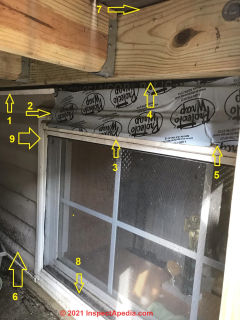 @Shelia,
@Shelia,
Thank you for a helpful window flashing leak question and photo.
I see in your photo at least 9 potential leak points/causes that could cause the window leak you cite, and doubtless an experienced onsite inspector would find both more-clues and also the most-likely leak cause.
Bottom line: the window flashing was not correctly installed and it's possible that the deck installation is also not properly flashed against the house. That combination sends water behind the siding and into the wall and thus into the building around the window. (Perhaps at other locations there are also less-obvious leaks, or water may be running down behind siding and out at its bottom.
If the water inside lets you trace wetness to the top of the window then the two failures I name above may be the principal cause of leakage.
If the water or wet areas inside do not extend above the window sill then I suspect the primary problem is roof drainage spilling onto the deck and below it and splashing-up into the window sill - again a window installation error of improper flashing at the sill and/or perhaps lower window sides.
Referring to my numbered arrows:
- Siding top J-flashing
suggests that the deck ledger board was installed to the house structure before siding was installed - which is good practice, but if flashing was omitted between and over the deck ledger and the house rain is sent behind the ledger board and down the wall and in at the window.
See DECK FLASHING - Someone added self-stick flashing tape
in an improper installation, improperly-placed, not adhered to the wall, and incomplete in length. - Drip stains below the flashing tape
may show that it's leaking (or they may be prior to its installation) - Flashing tape open at top
lets water run behind it, rendering it useless - Flashing tape is wrinkled
and forms another water transmission path - Rain splash-up
soil on the siding near wall bottom tells me the house has no working gutter or roof drainage system, adding to the water load on the wall and under the deck. - No visible flashing at the deck ledger board
probably one of the two prime causes of leakage in this location - The large amount of dirt in the sill
of the window tells me that rain splash-up (again no working roof gutter or drain system) is pouring water and dirt into this window sill. - Not-shown: It is likely that the basement window was not properly installed
in that it was not properly-flashed during construction; using stick-atop flashing tape will never fix this problem.
On 2021-07-25 by Shelia
I moved into a new construction home in 2004, shortly after(2-3 months) I noticed water stain above window when it rains. Since then when I get windy rain, not every rain the Sheetrock gets wet. I’ve caulked around windows but it doesn’t help and when I wet the actual window with a hose it doesn’t leak .
I’ve had a few company’s , window, siding and roofing check it out but no one has a definite answer.
Should I remove siding to check for damage or could it be the way windows were Installed ?
The piece of siding was removed when I had deck redone but the water problem were occurring way before this work was done. The window is the basement window that sits parrot below the deck.

On 2021-07-14 - by (mod) -
@sponge7,
I recall taking the photo and noting that because the leaking occurred at multiple spots and shows up at the bottom of the gable-end upper triangle horizontal siding, the most-likely cause is wind-blown rain that penetrates the siding, wets the sheathing or house-wrap, and appears as a water "leak" at the bottom of the siding installation.
A proper diagnostic inspection, not possible in this case, would involve a careful look in the attic as well as inspecting the occupied space along this wall, from indoors, and an inspection in the crawl space too - looking for signs that water penetrates the walls structure. If that is happening then we face wet insulation, mold, insect attack risks on the building and long-term, rot damage too.
On 2021-07-14 by sponge7
Note that I'm referring to this image:
Hi there, you mentioned that the top photo shows "water leaking out of gable end siding on a condominium complex in Maine". What is the cause of this problem and what can be done to fix it?
On 2021-07-06 by (mod) - possible leaks at aluminum-wrapped window trim
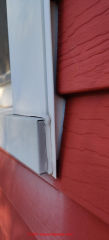 @seawall90,
@seawall90,
If you are referring to the aluminum window wrap in your photo, ... as Mark Cramer says: it depends.
IF the aluminum was properly bent-up and formed on the horizontal surface before the vertical window trim wrap was installed,
THEN the fact that the silicone caulk was applied "in the vicinity of" the opening but completely fails to seal it, won't result in an actual water leak behind the siding and into the window sill assembly.
ELSE yes, that open caulk joint risks leaks into the trim wrap and possibly down behind the building siding where, over time it can invite rot, mold, or insect attack.
It would make sense to peel off the ineffective caulk bead and to apply the caulk properly so that it actually seals the openings around the sill and keeps any rain or wind-blown rain out of the trim wrap.
Aside: the wash-down of white oxides from the white window trip wrap onto the red siding suggests that this installation is not new - it's been there for some time, perhaps years; so there's been enough chance of water entry that you'd be alert as well for water stains or leak signs inside the building below the window; if there is a basement or crawl space below, inspect there as well.
Now that I see that second photo: looks as if there are leaks above that point.
Thanks for the excellent photo and question.
On 2021-07-06 y seawall90
Is this suspect, the window/interface? [Photo above]
I bought an as-is older home (1910, with additions and various DIY looking repairs).
On the siding, I see water coming back onto exterior of siding at lower levels.
Also, looks like poor sealing at window inserts. Any suggestions for further inspection?
On 2021-04-18 - by (mod) -
@Carmella McConn,
I'm afraid that I don't have a clear understanding of the exact problem that we are solving and although I took a look at your photo I can't see enough detail.
 But certainly something that should be encouraging is the thought that there's no problem we are going to discover of this nature that hasn't come up before and that doesn't have the solution. Normally if the problem is a leak at the abutment of the chimney to the house wall or I should say the chimney enclosure to the house wall That's All by the installation of proper flashing that is later covered by siding and trim. It's not clear to me why you need to have flashing remaining exposed in those locations.
But certainly something that should be encouraging is the thought that there's no problem we are going to discover of this nature that hasn't come up before and that doesn't have the solution. Normally if the problem is a leak at the abutment of the chimney to the house wall or I should say the chimney enclosure to the house wall That's All by the installation of proper flashing that is later covered by siding and trim. It's not clear to me why you need to have flashing remaining exposed in those locations.
On 2021-04-18 by Carmella McConn
I am having new vinyl siding installed on a tri-level house with a fireplace. The previous siding was a wood composite siding and there was a great deal of water damage/wood rot in several areas upon removal.
The chimney is on the east side of the house and was previously sided all the way up. The siding contractor has installed some metal material (flashing?) on each side of the chimney between the siding, which is a total eyesore, and insists this is the only solution to avoid water damage caused by the previous siding installation.
(There was no metal involved in the previous siding.) Other options were to use roofing shingles or limestone.
Is there any other method to do this with more aesthetic results? ANY suggestions would be appreciated.
Thanks,
Carmella
On 2018-10-27 - by (mod) - a water hose could be a way to search for leaks?
Applied with some sense, yes.
Don't squirt water up the under-side of aluminum or vinyl siding.
On 2018-10-27 by Anonymous
Thank you. So, then would you agree that a water hose could be a way to search for leaks?
...
Continue reading at SIDING LEAK POINTS & CAUSES or select a topic from the closely-related articles below, or see the complete ARTICLE INDEX.
Or see SIDING LEAK DIAGNOSIS & REPAIR FAQs - questions and answers about leaky siding that were posted originally on this page.
Or see these
Recommended Articles
- DIRECT VENT INSTALLATION, SNAFUS & SPECS - explains the photo at above right
- GUTTERS & DOWNSPOUTS - leaks can send so much water down a wall that the wall is damaged and leaks
- FLASHING on BUILDINGS - home
- HOUSEWRAP INSTALLATION - improperly-installed, invites leaks into the structure
- ROOF ICE DAM LEAKS - can send water into building siding systems or into the wall cavity
- SIDING, FIBER CEMENT GAPS - installation or shrinkage gaps can leak into the wall leaks
- SIDING LEAK DIAGNOSIS & REPAIR
- SIDING LEAK POINTS & CAUSES
- SIDING WOOD, FLASHING DETAILS
- OVERLAP SPECIFICATIONS for HORIZONTAL VINYL SIDING JOINTS- gaps mean leaks
- VINYL SIDING BUCKLED WARPED
- VINYL SIDING GAPS, HOLES, CRACKS
- WATER ENTRY in BUILDINGS - complete catalog of sources of building leaks & water entry
Suggested citation for this web page
SIDING LEAK DIAGNOSIS & REPAIR at InspectApedia.com - online encyclopedia of building & environmental inspection, testing, diagnosis, repair, & problem prevention advice.
Or see this
INDEX to RELATED ARTICLES: ARTICLE INDEX to BUILDING SIDING
Or use the SEARCH BOX found below to Ask a Question or Search InspectApedia
Ask a Question or Search InspectApedia
Try the search box just below, or if you prefer, post a question or comment in the Comments box below and we will respond promptly.
Search the InspectApedia website
Note: appearance of your Comment below may be delayed: if your comment contains an image, photograph, web link, or text that looks to the software as if it might be a web link, your posting will appear after it has been approved by a moderator. Apologies for the delay.
Only one image can be added per comment but you can post as many comments, and therefore images, as you like.
You will not receive a notification when a response to your question has been posted.
Please bookmark this page to make it easy for you to check back for our response.
IF above you see "Comment Form is loading comments..." then COMMENT BOX - countable.ca / bawkbox.com IS NOT WORKING.
In any case you are welcome to send an email directly to us at InspectApedia.com at editor@inspectApedia.com
We'll reply to you directly. Please help us help you by noting, in your email, the URL of the InspectApedia page where you wanted to comment.
Citations & References
In addition to any citations in the article above, a full list is available on request.
- In addition to citations & references found in this article, see the research citations given at the end of the related articles found at our suggested
CONTINUE READING or RECOMMENDED ARTICLES.
- Carson, Dunlop & Associates Ltd., 120 Carlton Street Suite 407, Toronto ON M5A 4K2. Tel: (416) 964-9415 1-800-268-7070 Email: info@carsondunlop.com. Alan Carson is a past president of ASHI, the American Society of Home Inspectors.
Thanks to Alan Carson and Bob Dunlop, for permission for InspectAPedia to use text excerpts from The HOME REFERENCE BOOK - the Encyclopedia of Homes and to use illustrations from The ILLUSTRATED HOME .
Carson Dunlop Associates provides extensive home inspection education and report writing material. In gratitude we provide links to tsome Carson Dunlop Associates products and services.


